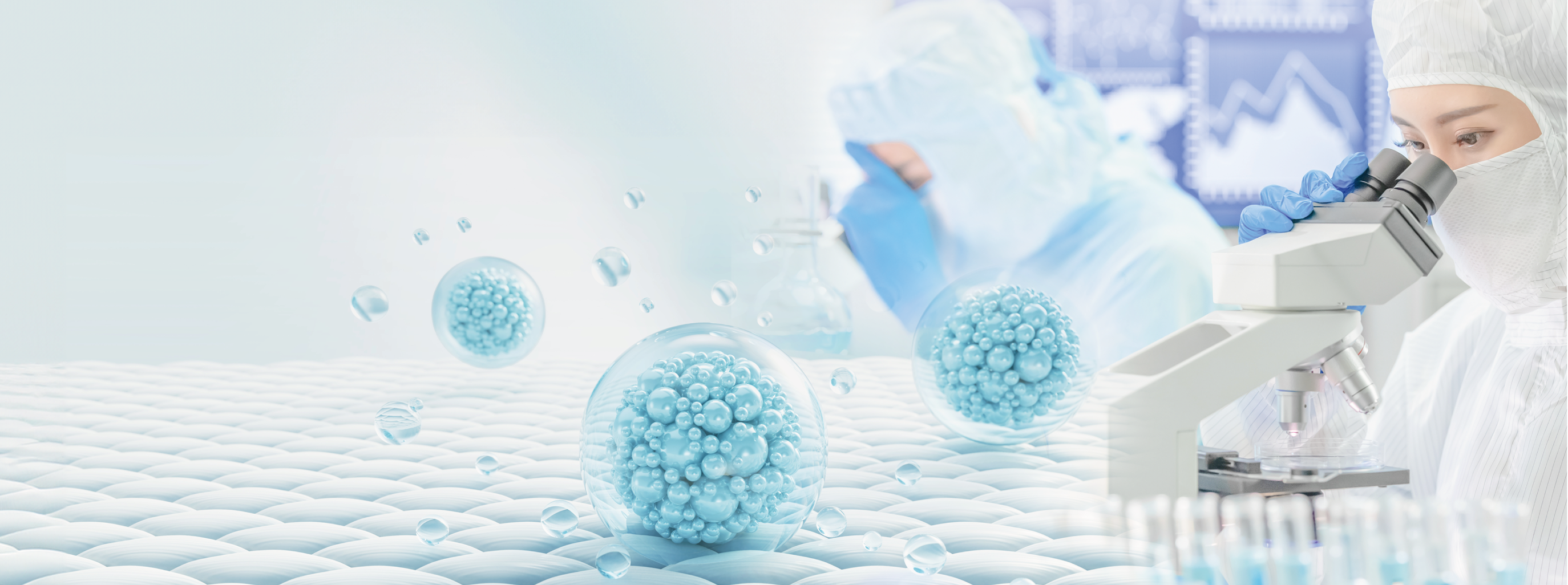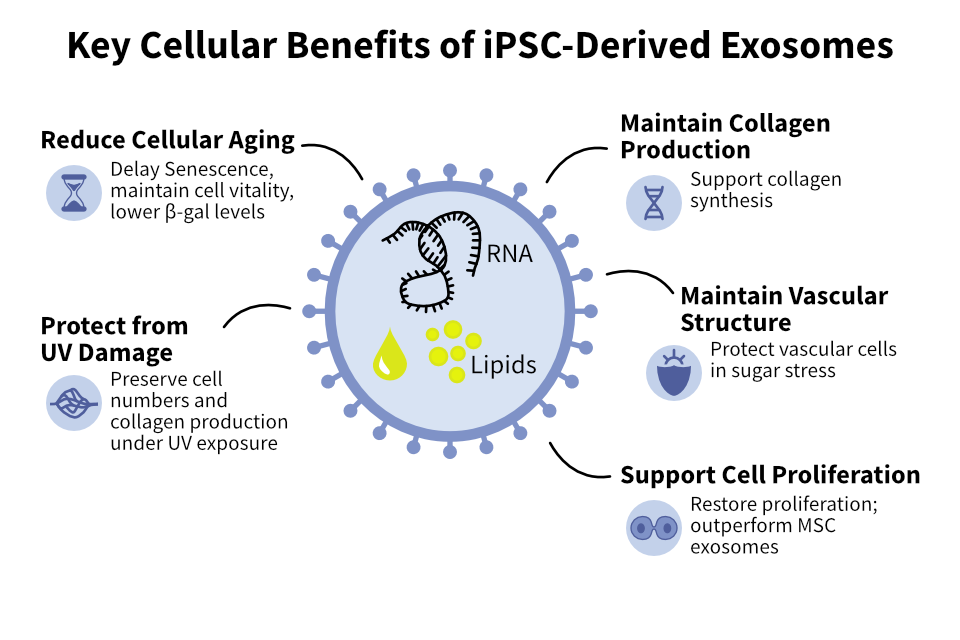- Clinical Stem Cell Services
- REPROCELL Japan GMP Manufacturing Facility
- Understanding iPSC-Derived Exosomes
Understanding iPSC-derived Exosomes

What Are Exosomes?
Cells naturally secrete a variety of substances, including extracellular vesicles ranging in size from approximately 30 nm to 5,000 nm. Within this spectrum, vesicles measuring 30 nm to 150 nm are known as exosomes, which are produced in the endoplasmic reticulum of most eukaryotic cells . Exosomes share the same double lipid membrane structure as the cell’s own membrane, and they can encapsulate a rich cargo of biologically active molecules, including proteins and nucleic acids (DNA, RNA).
Protein cargo typically contains membrane proteins such as integrins, MHC molecules, and tetraspanins, as well as heat shock proteins and cytoskeletal proteins. The nucleic acid cargo often contains DNA, messenger RNA (mRNA), and microRNA (miRNA).
Once secreted, exosomes travel through bodily fluids to reach distant cells. Upon uptake by recipient cells, the proteins and nucleic acids they carry can modulate cellular function—serving as a powerful means of intercellular communication.
Why Use iPSC-derived Exosomes?
Our bodies age cell by cell. Each time a cell divides, it moves one step closer to senescence—a state where it can no longer rejuvenate or multiply. Once cells reach this stage, the body’s ability to repair itself declines, which is why wounds heal more slowly with age.
A key factor in this process lies in telomeres—the protective caps at the ends of our chromosomes. With each cell division, telomeres gradually shorten, acting like a biological clock that counts down a cell’s lifespan (Figure 1).

Research has shown that when iPSCs are generated from senescent cells, which are characterized by shortened telomeres, the telomeres lengthen again, restoring them to a pre-senescent state. In effect, iPSCs rewind cellular time, reversing the ageing process at the genomic level. Reprogramming returns cells to a state comparable to the embryonic blastocyst stage of early development, when telomeres are long, robust, and primed for renewal. From this observation comes a new generation of tools: iPSC-derived exosomes.
Why Purified iPSC Exosomes Matter?
These nanoscale vesicles are naturally loaded with bioactive molecules—proteins, RNAs, and lipids—that mirror the rejuvenating properties of their parent iPSCs. With high purity and rigorous, multi-stage quality control, exosomes are designed for advanced anti-ageing applications, enabling scientists to explore the cellular pathways behind rejuvenation, tissue repair, and regeneration.
Explore REPROCELL's iPSC-derived Exosomes – manufactured at REPROCELL Japan GMP Manufacturing Facility.
Applications of iPSC Exosomes in Regenerative Medicine and Research
Key Benefits at a Glance
Below is a curated summary of reported findings on the effects of iPSC-derived exosomes across different cell types backed by existing published research. For more details, see Frequently Asked Questions: iPSC Exosomes - Preclinical Research Overview.
| Application | Cell Type | Effect of iPSC Exosomes | Reference |
|---|---|---|---|
| Reduce Cellular Aging | Fibroblasts | Lower β-gal levels, maintain cell vitality, delay senescence | Ref. 1 |
| Maintain Collagen Production | Fibroblasts | Sustain collagen production, supporting healthier, resilient cells | Ref. 1 |
| Protect from UV Damage | Fibroblasts | Preserve cell numbers and collagen production after UV exposure | Ref. 1 |
| Maintain Vascular Structure | Vascular Cells | Preserve cell numbers and structure under high-sugar conditions | Ref. 2 |
| Support Cell Proliferation | Stem Cells (MSC & iPSC) | Restore proliferative capacity; outperform MSC-derived exosomes | Ref. 3,4,5 |
References
-
Oh, M., Lee, J., Kim, Y.J., Rhee, W.J. and Park, J.H. Exosomes Derived from Human Induced Pluripotent Stem Cells Ameliorate the Aging of Skin Fibroblasts. International Journal of Molecular Sciences. 19, 1715. 2018.
- Ding, Q., Sun, R., Wang, P., Zhang, H., Xiang, M., Meng, D., Sun, N., Chen, A.F. and Chen, S. Protective effects of human induced pluripotent stem cell-derived exosomes on high glucose-induced injury in human endothelial cells. Experimental and therapeutic medicine. 15, 4791-4797. 2018.
-
Kim, S., Lee, S.K., Kim, H. and Kim, T.M. Exosomes Secreted from Induced Pluripotent Stem Cell-Derived Mesenchymal Stem Cells Accelerate Skin Cell Proliferation. International Journal of Molecular Sciences. 19, 2018.
-
Liu, S., Mahairaki, V., Bai, H., Ding, Z., Li, J., Witwer, K.W. and Cheng, L. Highly Purified Human Extracellular Vesicles Produced by Stem Cells Alleviate Aging Cellular Phenotypes of Senescent Human Cells. Stem Cells. 37, 779-790. 2019.
-
Wang, S., Hou, Y., Li, X., Song, Z., Sun, B., Li, X. and Zhang, H. Comparison of exosomes derived from induced pluripotent stem cells and mesenchymal stem cells as therapeutic nanoparticles for treatment of corneal epithelial defects. Aging (Albany NY). 12, 19546-19562. 2020.
Inquire About REPROCELL's iPSC Exosomes
Discover more
Resources
- FAQ: Clinical iPSCs
- FAQ: Clinical MSCs
- FAQ: iPSC-Derived Exosomes
- Making iPSC-Derived Therapeutics a Clinical Reality – our external article in the European Biopharmaceutical Review.
Gene Editing Services
